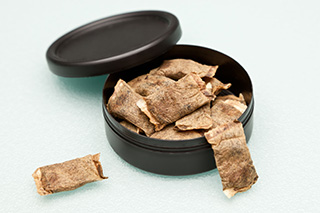Key Points
- Smokeless tobacco is tobacco that is not burned. Smokeless tobacco is also known as chewing tobacco, oral tobacco, spit or spitting tobacco, dip, chew, and snuff/snus.
- Smokeless tobacco causes cancer and other diseases.
- Smokeless tobacco is not a safe substitute for cigarettes.
What is smokeless tobacco?
Smokeless tobacco is tobacco that is not burned. It is also known as chewing tobacco, oral tobacco, spit or spitting tobacco, dip, chew, and snuff. Most people chew or suck (dip) the tobacco in their mouth and spit out the tobacco juices that build up, although “spitless” smokeless tobacco has also been developed. Nicotine in the tobacco is absorbed through the lining of the mouth.
People in many regions and countries, including North America, northern Europe, India and other Asian countries, and parts of Africa, have a long history of using smokeless tobacco products.
There are two main types of smokeless tobacco:
• Chewing tobacco, which is available as loose leaves, plugs (bricks), or twists of rope. A piece of tobacco is placed between the cheek and lower lip, typically toward the back of the mouth. It is either chewed or held in place. Saliva is spit or swallowed.
• Snuff, which is finely cut or powdered tobacco. It may be sold in different scents and flavors. It is packaged moist or dry; most American snuff is moist. It is available loose, in dissolvable lozenges or strips, or in small pouches similar to tea bags. The user places a pinch or pouch of moist snuff between the cheek and gums or behind the upper or lower lip. Another name for moist snuff is snus (pronounced “snoose”). Some people inhale dry snuff into the nose.
Are there harmful chemicals in smokeless tobacco?
Yes. There is no safe form of tobacco. At least 28 chemicals in smokeless tobacco have been found to cause cancer (1). The most harmful chemicals in smokeless tobacco are tobacco-specific nitrosamines, which are formed during the growing, curing, fermenting, and aging of tobacco. The level of tobacco-specific nitrosamines varies by product. Scientists have found that the nitrosamine level is directly related to the risk of cancer.
In addition to a variety of nitrosamines, other cancer-causing substances in smokeless tobacco include polonium–210 (a radioactive element found in tobacco fertilizer) and polynuclear aromatic hydrocarbons (also known as polycyclic aromatic hydrocarbons) (1).
Does smokeless tobacco cause cancer?
Yes. Smokeless tobacco causes oral cancer, esophageal cancer, and pancreatic cancer (1).
Does smokeless tobacco cause other diseases?
Yes. Using smokeless tobacco may also cause heart disease, gum disease, and oral lesions other than cancer, such as leukoplakia (precancerous white patches in the mouth) (1).
Can a user get addicted to smokeless tobacco?
Yes. All tobacco products, including smokeless tobacco, contain nicotine, which is addictive (1). Users of smokeless tobacco and users of cigarettes have comparable levels of nicotine in the blood. In users of smokeless tobacco, nicotine is absorbed through the mouth tissues directly into the blood, where it goes to the brain. Even after the tobacco is removed from the mouth, nicotine continues to be absorbed into the bloodstream. Also, the nicotine stays in the blood longer for users of smokeless tobacco than for smokers (2).
The level of nicotine in the blood depends on the amount of nicotine in the smokeless tobacco product, the tobacco cut size, the product’s pH (a measure of its acidity or basicity), and other factors (3).
A Centers for Disease Control and Prevention study of the 40 most widely used popular brands of moist snuff showed that the amount of nicotine per gram of tobacco ranged from 4.4 milligrams to 25.0 milligrams (3). Other studies have shown that moist snuff had between 4.7 and 24.3 milligrams per gram of tobacco, dry snuff had between 10.5 and 24.8 milligrams per gram of tobacco, and chewing tobacco had between 3.4 and 39.7 milligrams per gram of tobacco (4).
